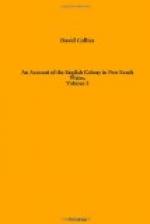At half past seven in the morning of Sunday the 9th they sounded, but without finding ground with fifteen fathoms of line, at the distance of half a mile from a small reef of black rocks, which ran off from a sugar-loaf point. There were two very low, and therefore dangerous rocks, lying at S 20 degrees E three or four miles, and SE about two miles from this point. Captain Cook passed this part of the coast in the night, and therefore did not see the rocks; but they required to be particularly looked out for by any vessel coming near the land.* The latitude of the point is about 32 degrees 27 minutes S, Cape Hawke lying N 1 degree or 2 degrees E from it; and the intermediate coast was mostly beach, but divided at intervals by short stony heads.
[* This and other nautical observations made by Lieutenant Flinders are inserted, as it is presumed they (never having been published) may be of use to such ships as may hereafter be employed in the whale fishery upon the coast.]
Sounding with ten fathoms of line at half a mile distance from the shore of Cape Hawke, they got ground. The two hills here mentioned by Captain Cook were found to stand upon the pitch of the Cape, and were covered with brush down to the low cliffs. The strata in these cliffs lay forty or fifty degrees from the horizontal line. From the Cape the coast falls back, forming a kind of double bay. The land was low, and rose, but very gradually, ridge over ridge inland to a moderate height, the country looking pleasant enough from the sea; but the trees appeared small, and mixed with brushwood.
At daylight in the morning of the 10th they perceived the vessel to have been carried by an extraordinary current considerably to the southward of their expected situation, and at noon their latitude gave them a difference of thirty-three miles, which current they attributed to their being five or six leagues off the shore; for in the preceding twenty-four hours, when she was close in with the shore, the difference between the observation and the log was eight miles in her favour.
They found this morning that the sloop had unfortunately sprung a very bad leak, which admitted so much water as kept one pump constantly at work. By its coming on suddenly, it was judged not to have been occasioned by any straining of the vessel. It was, however, a serious cause of alarm; and the maize with which the sloop had been before loaded was continually choking up the pumps.
The Solitary Isles were seen on the 11th. It had been Mr. Flinders’s intention to have landed upon some of these islets, had any inducement presented itself; but on them he saw not either seal or bird. They seemed to be covered with short brush; and two of them having been lately burnt proved that they were visited by natives. In the colour of the rock, and in their general appearance, they much resembled the small islands lying off Tasman’s heads, and might with equal propriety be termed the Miserable




